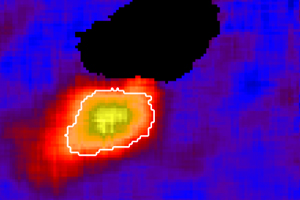Specks from a supernova
Asher Klein, ’11
Image courtesy Nicolas Dauphas
Chromium 54 is an isotope produced in nature only by supernovae, exploding stars that can shine billions of times brighter than the sun. On earth the mineral is so rare that it is almost nonexistent. Scientists have long suspected that a supernova kickstarted the solar system but had never found physical proof, at least until last year, when cosmochemist Nicolas Dauphas found two grains of chromium 54 (isotopic image at right) in a tiny sample of a 150-year-old meteorite called Orgueil (that’s French for “pride”).

Dauphas and his team spent three weeks in the summer of 2009 at CalTech, sifting through the 1,500 meteorite particles, each about 500 times too small to be seen by the naked eye, looking for a trace of the element. The discovery was published September 10 in Astrophysical Journal. They used an ion microprobe, firing excited oxygen particles at the samples, generating an aura of secondary ions that they then mapped. By the end of the third week, when only one sample had presented the signature of chromium 54 and with the team in need of confirmation, things got desperate. Dauphas told one colleague on his way back to his hotel, “If you find the grain, please call me, no matter what.”
The two positive grains now sit in a box in Dauphas’s campus office, embedded in gold ingots to keep them in one place. Technically, they prove only that a supernova occurred in our neck of the universe. It’s the fact that chromium 54 isn’t dispersed evenly throughout the solar system that leads scientists to speculate the supernova started it.
Further and more sophisticated tests will be possible in the near future, when the geophysical-sciences department completes a new instrument with “unprecedented levels of resolution,” according to the project’s leader, cosmochemist Andrew M. Davis. “We’ll be able to examine smaller things than anyone ever before.” On the horizon for the device, called the Chicago Instrument for Laser Ionization, or CHILI, is trying to detect another ion—calcium 48—whose presence or absence will point to the type of supernova that exploded those 4.5 billion years ago, Dauphas says. Already under construction thanks to NASA and University of Chicago funding, CHILI is scheduled to begin testing the “grains that condensed around dying stars,” as Davis put it, within the year.
Return to top
